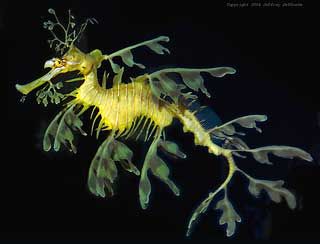Fish: Leafy Sea Dragon

Description
The Leafy Sea Dragon (Phycodurus eques) is a marine fish related to the seahorse. These creatures are native to the waters around southern and western Australia and generally remain in shallow, temperate waters. Their name comes from their appearance, with long leaf-like protrusions coming from all over the body. Much like the seahorse their name comes from a chance resemblance to a known (in this case mythical) creature. While not large by sea monster standards, they are very large for sea horses, growing at least 18 inches (45 cm).
They feed on plankton and other small flotsam, and are not preyed upon by any species other than humans. Females deposit eggs on the tail of the male where they grow to maturity. They have become endangered through pollution and industrial runoff as well as collection by fascinated divers who are entranced by their unique appearance. In response to these dangers they have been officially protected by the Australian government. As of 2004, only 3 professional aquariums had succeeded in keeping sea dragons.



3 Comments:
Damn humans have to prey on everything :/
By Blueyes, at 19:17
Blueyes, at 19:17
seems so ... unfortunately :(
By Daldianus, at 19:26
Daldianus, at 19:26
I have been fortunate enough to see these amazing creatures at the Florida Aquarium in Tampa. They are absolutely beautiful, mesmorizing creatures. I could have spent hours looking at them, and it's such a shame that they are so endangered in need of protecting. Anyone who hasn't had the privilege of seeing them in person (even if it is in a licensed aquarium fish tank) should really make the point of going, you won't regret it.
By Anonymous, at 17:08
Anonymous, at 17:08
Post a Comment
<< Home